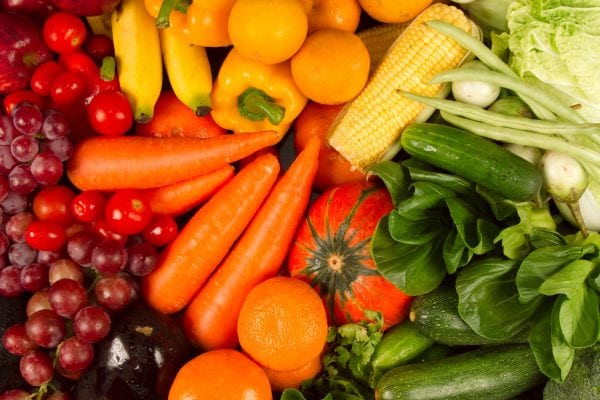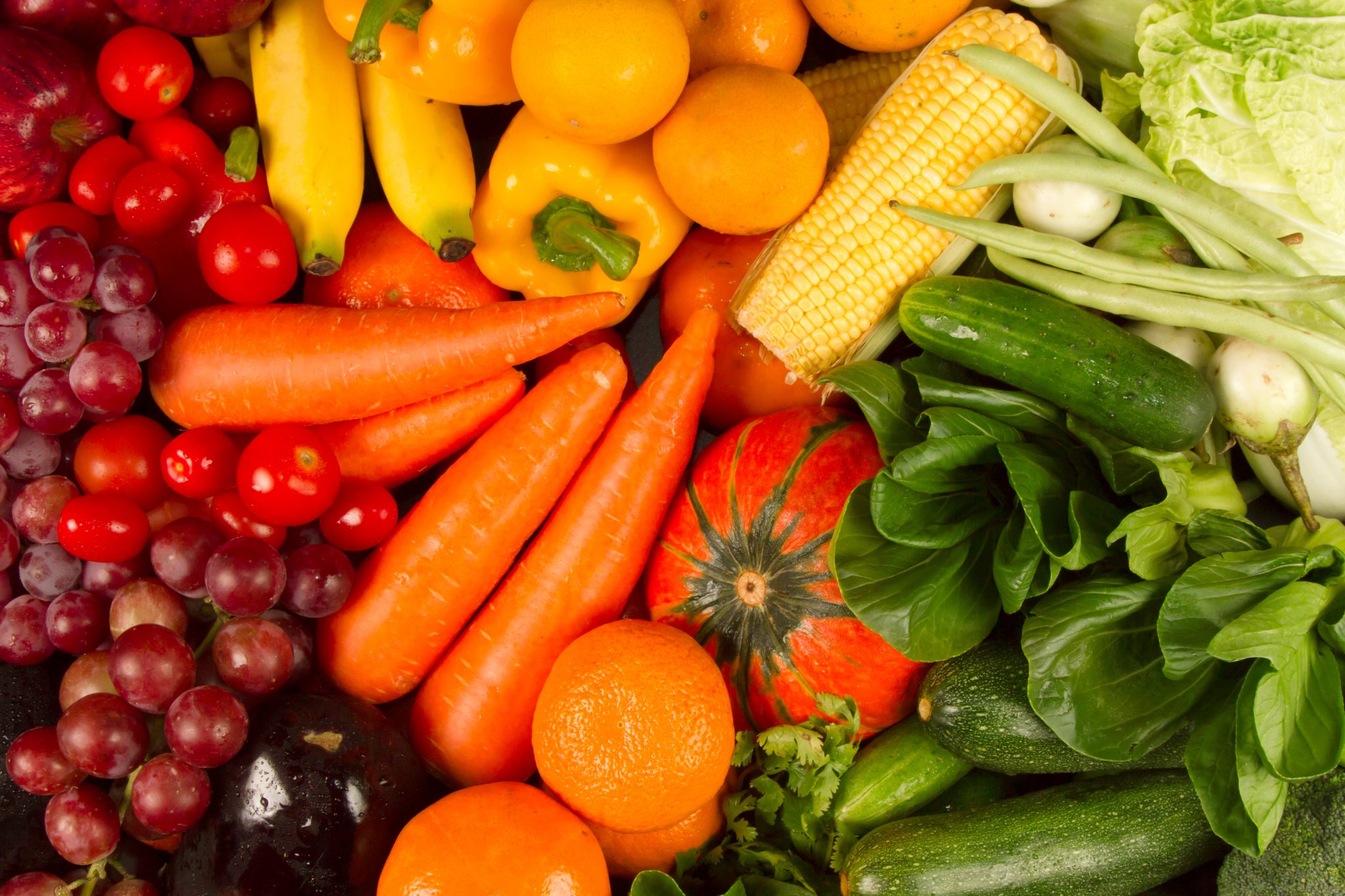Fruits & Vegetables

Methods of plant breeding are tools to address the increasing pressures of disease, pests, and environmental disasters on crop production and food security.
Introduction

Figure 1. Most of our food has not been bioengineered. Stock image by piyaset.
Farmers have purposefully changed the genetic makeup of crops since the beginning of domestic agriculture over 10,000 years ago. The variety of food choices we have today is a direct result of past and present methods of genetic modification to build diversity in agricultural food crops. Genetic engineering is one method used in modern agriculture to create bioengineered crops (BE crops). The varied methods of plant breeding are modern agriculture’s tools to address the increasing pressures of disease, pests, and environmental disasters on crop production and food security.
Agriculture & Crop Domestication
- Agriculture began more than 10,000 years ago when farmers cultivated crops for consumption and livelihood. Domestic agriculture allowed farmers to begin genetically modifying plants to improve crop production.
- Cultivating crops allowed early farmers to choose crops with characteristics that suited their needs. Subsequent seasons of selecting crops with particular characteristics and saving their seeds for planting led to the domestication of current food sources. This process is known as selective breeding.
- During the 1700s farmers learned to increase genetic diversity and introduce new beneficial characteristics into crops by ‘pairing’ similar species to produce several generations of hybrid offspring. This process is known as cross breeding.
History of Genetic Coding & Bioengineered Crops
- During the 1940s and 1950s, scientists discovered deoxyribonucleic acid (DNA) that provides the genetic code or genes of all living organisms. DNA allowed researchers to explore and develop methods that would introduce or enhance desirable traits into plant gene pools. These methods involved using chemicals or radiation as a means to mutate plants.
- During the 1980s, genetic engineering technology was applied to introduce or to enhance traits in plants. Initial research efforts looked at introducing pests, disease, and herbicide resistance traits. Already being used in the medical industry, genetic engineering was another tool used to develop new and/or enhanced traits to crops and included such methods as RNA interference and transgenesis. RNA interference prevents genetic information or expression (messenger RNA/mRNA), while transgenesis allows a living organism to exhibit a new property or trait that can be carried to its offspring.
- After rigorous testing by federal agencies such as the United States Department of Agriculture, the United States Environmental Protection Agency and the United States Food and Drug Administration, the first BE crops such as papaya, corn, soybean, and cotton were introduced in the 1990s.
- Since the early 2000s, the technology of gene editing has the potential to turn genes on and off or precisely remove them to create desirable traits in crops. This technology does not introduce foreign DNA into the host plant genome like transgenesis. Instead, it works with the existing host (plant) genome.
Figure 2. Crop modification methods currently used in agriculture.
Traditional Breeding |
Mutagenesis |
RNA Interference |
Transgenesis |
Gene Editing |
|---|---|---|---|---|
Plants with desired traits are selected/crossed to produce offspring. | Changes in genome using chemicals or radiation, very unpredictable | Inhibit gene expression by neutralizing mRNA. | Desired gene(s) inserted into specific locations | Specific alterations to plant genome. |
No testing required | No testing required | Testing required | Testing required | Testing required |
Yes for organic use | Yes for organic use | Unknown for organic use | No for organic use | Unknown for organic use |
| Number of Genes Affected | ||||
10K to >300K | Unknown | 1-2 | 1-3 | 1-3 |
Modern Agriculture & Genetic Engineering Facts
- The United States food supply is considered one of the safest & most abundant food supplies in the world.
- Approximately 1.4% of the United States population produces food for the remaining population.
- Most Americans are currently three or more generations removed from the farm and no longer have first-hand knowledge of how food is produced.
- Modern food production has developed into several different breeding and growing methods, all of which compete for market share.
- Misinformation, marketing and increased awareness of food insecurity have led to confusion as to the nutrition, health, and safety of modern agricultural food products.
- Bioengineered (BE) crops developed with genetic engineering enable scientists to take useful traits found in nature and transfer them to a plant of interest, or to make changes to an existing trait in a plant.
- The methods used to create BE crops are the most researched and regulated ever used in agriculture for crop development and improvement.
- BE crops are created with a specific, desired trait in mind. For example, resistance to a pest, disease, chemical or to enhance nutritional value.
- Farmers will choose seeds and cropping methods that are best suited for their farms and businesses. They determine which seeds, inputs and management practices are best for their land, business and growing conditions. There are a variety of seed options for farmers to choose from, including genetically modified, conventional and organic seeds.
- Farmers need good tools to g row their crops and food productively while optimizing their inputs while assuring food security and safety.
- BE crop development is a costly and timely enterprise for corporations to invest in (13 years /$138 million). The use of genetic engineering for crop development is a last resort when all other modification techniques are not feasible.
Safety of Bioengineered Crops
- The National Academies of Sciences, Engineering and Medicine reviewed more than 900 scientific studies and publications based on 20+ years of data and determined that genetically engineered or modified crops (GMOs) were safe for humans, the environment, animals, and beneficial insects and pollinators.
“No substantiated evidence of a difference in risk to human health between currently commercially available genetically engineered (GMO) crops and conventionally bred crops.” – National Academies of Sciences, Engineering and Medicine.
- Food derived from BE crops are nutritionally the same and safe as their conventional counterparts.
- Health, growth and performance of animals fed BE crops are the same as animals fed with conventional source feed. Nutrition and safety is the same whether animals are fed BE feed or non-BE feed.
- The use of BE crops with modern agriculture conservation practices and integrated pest management (IMP) has allowed farmers to grow more with less impact on the environment. It has been estimated that without the use of BE crops, more land (48 million acres) would need to be planted to produce the same amount of food.
- The use of BE crops helps to reduce CO2 emissions by 59 million pounds, which is equivalent to removing 12 million cars from the road for a year.
- Using BE crops helps to reduce the need for pesticides, thus reducing environmental harm or risk by 19 percent.
References
Brookes, G., & Barfoot, P. (2017, June.). GM crops: Global, socio-economic and environmental impacts 1996-2015. Retrieved from https://www.pgeconomics.co.uk/pdf/2017globalimpactstudy.pdf.
National Academies of Sciences, Engineering, and Medicine. (2016). Genetically engineered crops: Experiences and prospects. The National Academies Press. Retrieved from https://doi.org/10.17226/23395.
Rudy Pacumbaba, PhD, Horticulture Specialist, Alabama A&M University
Reviewed February 2022, GMO Food Facts: Bioengineered Crops, UNP-2135






